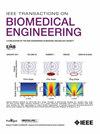Perovskite Quantum Dot-Based Photovoltaic Biointerface for Photostimulation of Neurons
IF 4.4
2区 医学
Q2 ENGINEERING, BIOMEDICAL
引用次数: 0
Abstract
用于神经元光刺激的基于 Perovskite 量子点的光伏生物界面。
目的:利用基于半导体的光电生物界面来替代天然光感受器,是防止视网膜退化、恢复视力的一条可行途径。方法:在此,我们合成了四甲基碘化铅铵(TMAPbI3)包晶量子点(QDs),作为光伏生物界面的新型光活性材料。TMAPbI3 量子点和电解质界面在光照下可产生法拉第光电流,而与 P3HT 的异质结则可将电荷转移过程转化为安全的电容性光电流,离子响应率提高到 17.4 mA/W:18 纳米厚度的量子点集成显示出与海马神经元原代培养物良好的生物相容性,生物界面的光响应触发了对神经元的光刺激。透辉石材料的兴起可刺激新型光电视网膜植入。
本文章由计算机程序翻译,如有差异,请以英文原文为准。
求助全文
约1分钟内获得全文
求助全文
来源期刊

IEEE Transactions on Biomedical Engineering
工程技术-工程:生物医学
CiteScore
9.40
自引率
4.30%
发文量
880
审稿时长
2.5 months
期刊介绍:
IEEE Transactions on Biomedical Engineering contains basic and applied papers dealing with biomedical engineering. Papers range from engineering development in methods and techniques with biomedical applications to experimental and clinical investigations with engineering contributions.
 求助内容:
求助内容: 应助结果提醒方式:
应助结果提醒方式:


